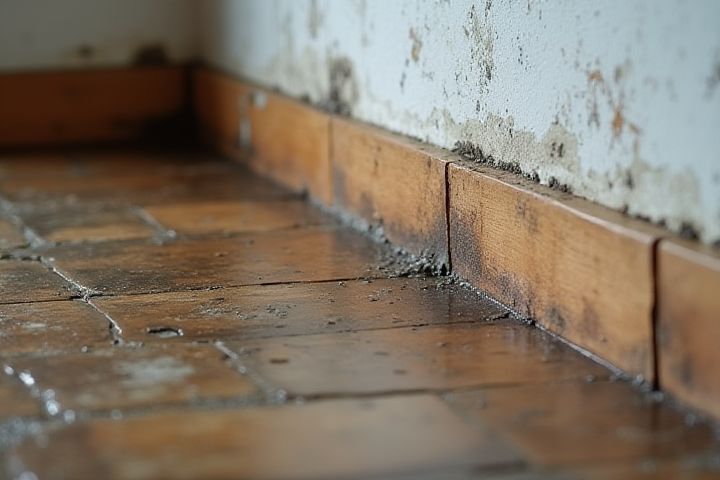
To address a damp house, first assess potential sources of moisture, such as leaking pipes, condensation, or inadequate ventilation. You can improve airflow by opening windows or using exhaust fans in kitchens and bathrooms to reduce humidity levels. Consider using a dehumidifier to extract excess moisture from the air and maintaining indoor relative humidity between 30% and 50%. Inspect areas for mold growth, especially in basements, bathrooms, and around windows, and treat any affected surfaces with mold removers. Finally, ensure your property has proper drainage and gutters to prevent water accumulation near your foundation.
What To Do When House Feels Damp
Improve ventilation
Improving ventilation in your home can significantly reduce dampness. Open windows regularly to promote air circulation, and consider installing vents or exhaust fans in moisture-prone areas like kitchens and bathrooms. You can also use a dehumidifier to maintain humidity levels below 50%, which helps inhibit mold growth. For optimal results, keep doors open between rooms to facilitate airflow throughout your living space.
Use a dehumidifier
A dehumidifier is an effective solution for combating dampness in your home, as it works to reduce humidity levels to a comfortable 30-50%. By extracting moisture from the air, a dehumidifier can help prevent mold growth and improve indoor air quality, which is crucial for your health. Aim for a unit that suits the size of your room; for example, a 30-pint model is ideal for smaller spaces, while larger areas may require a 50-pint or more powerful unit. Regularly empty the collected water and maintain the appliance to ensure maximum efficiency and longevity.
Fix any leaks
Inspect your home thoroughly to identify any leaks, paying particular attention to plumbing fixtures, roofs, and windows. Seal any cracks or gaps found in walls or around windows to prevent moisture from entering your living space. Ensure that your gutters and downspouts are clear of debris to direct rainwater away from your foundation. Regularly check and maintain appliances like washing machines and dishwashers, as these can also contribute to excess moisture if not properly managed.
Insulate properly
To effectively address dampness in your house, proper insulation is essential for maintaining a dry environment. Ensure that your walls, loft, and floors are insulated with materials such as mineral wool or spray foam, which can significantly reduce moisture ingress. Installing vapor barriers where necessary can also help prevent condensation from forming in colder areas. Regularly check for gaps and seal them, as even small openings can lead to increased humidity and dampness in your home.
Maintain gutters and downspouts
To combat dampness in your house, maintaining your gutters and downspouts is crucial. Ensure that your gutters are free from debris and clogs, which can lead to overflow and water pooling around your home's foundation. Ideally, downspouts should extend at least 6 feet away from your property to effectively direct water away. Regularly inspecting and cleaning these systems can reduce excess moisture and prevent potential mold growth, safeguarding both your health and property value.
Seal windows and doors
To effectively combat dampness in your home, prioritize sealing windows and doors, as these are common entry points for moisture. Use high-quality weatherstripping or caulk to seal any gaps or cracks around frames, which can significantly reduce drafts and prevent water infiltration. Regularly inspect these areas, aiming for at least an annual check, to ensure continued effectiveness. By maintaining a tight seal, you can help stabilize your indoor humidity levels and create a more comfortable living environment.
Use moisture-absorbing materials
Using moisture-absorbing materials can significantly reduce dampness in your home. Silica gel packets, activated charcoal, or specially designed moisture absorbers can help lower humidity levels effectively. For larger areas, consider installing hygroscopic materials such as calcium chloride or using dehumidifiers that can remove up to 30 pints of moisture daily. Regularly check and replace these materials as needed to maintain a comfortable and dry indoor environment.
Check for mold growth
Check for mold growth in areas of your home that are prone to moisture, such as bathrooms, kitchens, and basements. Inspect surfaces for any visible mold, which can appear as dark spots or fuzzy patches, and be mindful of any musty odors indicating hidden mold. If you discover mold, ensure you wear protective gear, including gloves and a mask, while removing it. For extensive mold issues, consider hiring a professional mold remediation service, as they can effectively treat the problem and prevent recurrence.
Arrange furniture for airflow
To combat dampness in your home, strategically arrange your furniture to promote better airflow. Position larger pieces, like sofas and cabinets, away from walls and allow at least a few inches of space to facilitate circulation. Consider using raised platforms for smaller items, which can create gaps underneath that enhance air movement. Regularly rearranging items such as books or decor can also help prevent moisture build-up in tight spaces.
Utilize exhaust fans
Utilizing exhaust fans effectively can significantly reduce dampness in your home. By installing fans in areas prone to moisture, such as bathrooms and kitchens, you can enhance air circulation and remove humid air. Aim to run these fans for at least 20 minutes after activities that generate moisture, like showering or cooking, to prevent condensation buildup. This simple step can improve your indoor air quality and create a healthier living environment, addressing the root cause of dampness.
